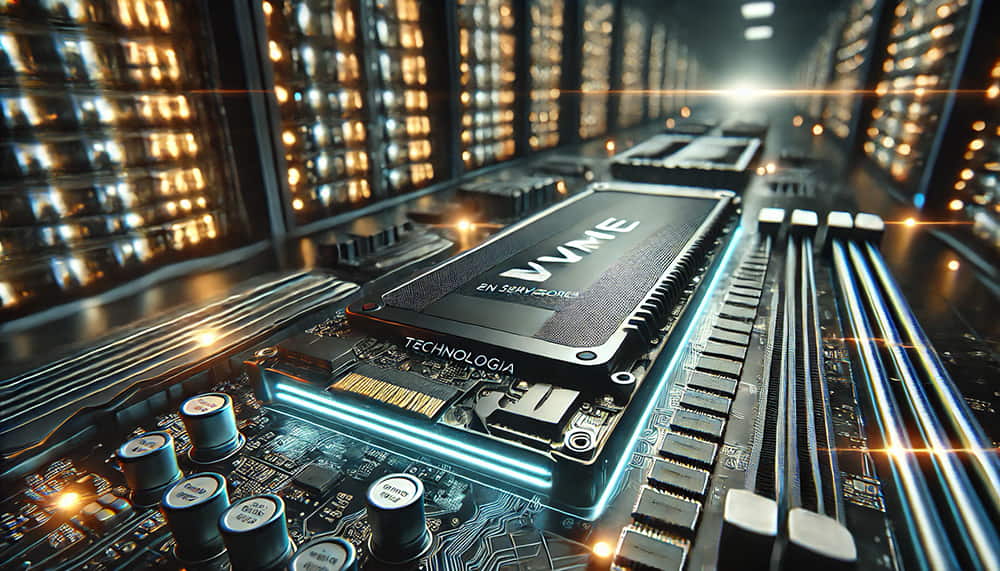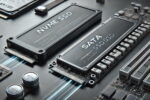NVMe (Non-Volatile Memory Express) technology has transformed the way servers handle storage, delivering impressive speeds and minimal latencies. In this article, we’ll explore what NVMe is, its benefits, and how to implement it in your server to maximize its performance.
You can see our entire range of servers at the following link.
What is NVMe and How Does It Work?
NVMe is a protocol designed specifically for modern solid-state drives (SSDs). It leverages the potential of flash memory and PCIe connectivity to provide significantly higher performance than previous technologies.
Differences between NVMe, SATA, and AHCI
- SATA: It was designed for traditional hard drives, with a maximum speed of 6 Gbps. Although it supports SSDs, it limits their performance.
- AHCI: A controller optimized for mechanical hard drives that does not take advantage of the capabilities of modern SSDs.
- NVMe: A high-speed protocol that uses PCIe connections, allowing for much faster transfers and a greater number of simultaneous operations.
High-speed data architecture
NVMe uses multiple parallel queues, each capable of handling thousands of commands, unlike AHCI, which is limited to a single queue with a maximum of 32 commands. This makes it ideal for high-performance server applications.
Advantages of NVMe Drives in Servers
Adopting NVMe in servers brings significant improvements in speed, efficiency, and responsiveness.
Transfer Speed: How Much Faster Is It?
NVMe drives are considerably faster than their SATA counterparts. For example:
- SATA SSD: Up to 550 MB/s read and write.
- NVMe SSD: From 3,500 MB/s on entry-level models to over 7,000 MB/s on next-generation drives.
This speed accelerates critical tasks like database access and application loading.
Reducing latency for critical applications
NVMe offers significantly lower latency, crucial for applications such as:
- Real-time databases: Faster processes and less waiting time.
- Virtualization: Better response time for virtual machines and simultaneous loads.
How to Integrate NVMe into Your Server
Integrating NVMe into a server requires considering factors such as compatibility and appropriate configurations.
Motherboard compatibility and RAID configurations
- Motherboards: Make sure your server has NVMe-compatible PCIe slots. Some modern motherboards include dedicated M.2 or U.2 slots for these drives.
- RAID Configuration: Using NVMe in RAID 0 or RAID 1 can increase speed or provide redundancy depending on your needs.
Top Brands and Models in 2024
- Samsung 990 PRO: Renowned for performance and reliability.
- WD Black SN850X: Ideal for high-performance servers.
- Seagate FireCuda 530: Renowned for durability and extreme speeds.
NVMe Technology Use Cases
NVMe is designed to meet the demands of the most demanding enterprise environments.
Database and virtualization servers
NVMe’s high speed and low latency make it ideal for:
- SQL and NoSQL databases: Improves performance in intensive queries.
- Virtualization: Allows multiple virtual machines to be handled more smoothly.
Mass storage infrastructures
In data centers and mass storage, NVMe is an increasingly common option due to its ability to handle large volumes of data quickly.
- Content Delivery Networks (CDNs): Faster transfers for end users.
- Big Data Analytics: More efficient processing of large amounts of information.
NVMe technology has redefined the standard for server storage, offering an unmatched combination of speed, efficiency, and responsiveness. Integrating it into your infrastructure can make a significant difference in the performance of critical applications and daily operations. Harness the power of NVMe and take your server to the next level!







